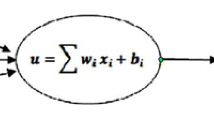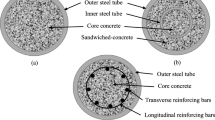Abstract
Concrete filled steel tube is constructed using various tube shapes to obtain most efficient properties of concrete core and steel tube. The compressive strength of concrete is considerably increased by the lateral confined steel tube in circular concrete filled steel tube (CCFT). The aim of this study is to present an integrated approach for predicting the steel-confined compressive strength of concrete in CCFT columns under axial loading based on large number of experimental data using artificial neural networks. Neural networks process information in a similar way that the human brain does. Neural networks learn by example. The main parameters investigated in this study include the compressive strength of unconfined concrete (\(f_{\text{c}}^{'}\)), outer diameter (D) and length (L) of column, wall thickness (t) and tensile yield stress (\(F_{\text{y}}\)) of steel tube. Subsequently, using the idealized network, empirical equations are developed for the confinement effect. The results of proposed model are compared with those of existing models on the basis of the experimental results. The findings indicate the precision and efficiency of ANN model for predicting the capacity of CCFT columns.















Similar content being viewed by others
References
Ahmadi M, Naderpour H, Kheyroddin A (2014) Utilization of artificial neural networks to prediction of the capacity of CCFT short columns subject to short term axial load. Arch Civ Mech Eng 14:510–517
Yu Z, Ding F, Cai CS (2007) Experimental behavior of circular concrete-filled steel tube stub columns. J Constr Steel Res 63:165–174
Lai MH, Ho JCM (2015) Effect of continuous spirals on uni-axial strength and ductility of CFST columns. J Constr Steel Res 104:235–249
Beheshti-Aval SB (2012) Strength evaluation of concrete-filled steel tubes subjected to axial-flexural loading by ACI and AISC-LRFD codes along with three dimensional nonlinear analysis. Int J Civ Eng 10:280–290
Perea T, Leon R (2014) Full-scale tests of slender concrete-filled tubes: interaction behavior. J Struct Eng 695:1–12
Rabunal JR, Dorado J (2006) Artificial neural networks in real-life applications. IGI Global
Ni H, Wang J (2000) Prediction of compressive strength of concrete by neural networks. Cem Concr Res 30:1245–1250
Naderpour H, Kheyroddin A, Amiri GG (2010) Prediction of FRP-confined compressive strength of concrete using artificial neural networks. Compos Struct 92:2817–2829
Lee S-C (2003) Prediction of concrete strength using artificial neural networks. Eng Struct 25:849–857
Oreta AWC, Kawashima K (2003) Neural network modeling of confined compressive strength and strain of circular concrete columns. J Struct Eng 129:554–561
Kaveh A, Maniat M (2014) Damage detection in skeletal structures based on charged system search optimization using incomplete modal data. Int J Civil Eng Trans A Civil Eng 12(2):193–200
Effati M, Rajabi MA, Samadzadegan F, Shabani S (2014) A geospatial based neuro-fuzzy modeling for regional transportation corridors hazardous zones identification. Int J Civil Eng Trans A Civil Eng 12(3):289–303
Perera R, Barchín M, Arteaga A, De Diego A (2010) Prediction of the ultimate strength of reinforced concrete beams FRP-strengthened in shear using neural networks. Compos Part B Eng 41:287–298
Kaveh A, Ghaffarian R (2015) Shape optimization of arch dams with frequency constraints by enhanced charged system search algorithm and neural network. Int J Civil Eng Trans A Civil Eng 13:102–111
Gardner NJ, Jacobson ER (1967) Structural behavior of concrete filled steel tubes. ACI J Proc 64:404–413
Gardner NJ (1968) Use of spiral welded steel tubes in pipe columns. ACI J Proc 65:937–942
Knowles RB, Park R (1969) Strength of concrete filled steel columns. J Struct Div 95:2565–2587
Cai SH (1984) A study on basic behavior and strength of concrete filled steel tubular short column. Structural Institute of China Building Research Academy
Kitada T, Yoshida Y, Nakai H (1987) Fundamental study on elastoplastic behavior of concrete encased steel short tubular columns. Mem Fac Eng Osaka City Univ 28:237–253
Tomii M, Xiao Y, Sakino K (1988) Experimental study on the properties of concrete confined in circular steel tube. In: Proc. 2nd Int. Conf. Concrete Filled Steel Tubular Struct, Harbin, China, pp 24–30
Tsuji B, Nakashima M, Morita S (1991) Axial compression behavior of concrete filled circular steel tubes. In: Proc. 3rd Int. Conf. Steel-Concrete Compos. Struct, Fukuoka, Japan, pp 19–24
Luksha LK, Nesterovich AP (1991) Strength testing of large-diameter concrete filled steel tubular members. In: Wakabayashi M (ed) Proc. Third Intl. Conf. Steel-Concrete Compos. Struct, Sept, pp 67–72
Sakino K, Hayashi H (1991) Behavior of concrete filled steel tubular stub columns under concentric loading. In: Wakabayashi M (ed) Proc. Third Int. Conf. Steel-Concrete Compos. Struct., Sept., pp 25–30
O’Shea MD, Bridge RQ (2000) Design of circular thin-walled concrete filled steel tubes. J Struct Eng 126:1295–1303
Kang HS, Lim SH, Moon TS (2002) Behavior of CFT stub columns filled with PCC on concentrically compressive load. J Arch Inst Korea 18:21–28
Giakoumelis G, Lam D (2004) Axial capacity of circular concrete-filled tube columns. J Constr Steel Res 60:1049–1068
Han L-H, Yao G-H (2003) Behaviour of concrete-filled hollow structural steel (HSS) columns with pre-load on the steel tubes. J Constr Steel Res 59:1455–1475
Han L-H, Yao G-H (2003) Influence of concrete compaction on the strength of concrete-filled steel RHS columns. J Constr Steel Res 59:751–767
Sakino K, Nakahara H, Morino S, Nishiyama I (2004) Behavior of centrally loaded concrete-filled steel-tube short columns. J Struct Eng 130:180–188
Zeghiche J, Chaoui K (2005) An experimental behaviour of concrete-filled steel tubular columns. J Constr Steel Res 61:53–66
Oliveira WLA (2008) Theoretical–experimental analysis of circular concrete filled steel columns. Doctoral thesis. São Carlos School of Engineering, University of São Paulo
Uy B, Tao Z, Han L-H (2011) Behaviour of short and slender concrete-filled stainless steel tubular columns. J Constr Steel Res 67:360–378
Denavit MD, Hajjar JF (2010) Nonlinear seismic analysis of circular concrete-filled steel tube members and frames. Report No. NSEL-023, Newmark Structural Laboratory Report Series (ISSN 1940-9826). Department of Civil and Environmental Engineering, University of Illinois at Urbana-Champaign, Urbana
Tully S (1997) A neural network approach for predicting the structural behaviour of concrete slabs. Master of engineering dissertation, Faculty of Engineering and Applied science memorial university of Newfoundland
Hu YH, Hwang J-N (2001) Handbook of neural network signal processing. CRC press
Beale MH, Hagan MT, Demuth HB (2010) Neural network toolbox 7: user’s guide. MathWorks, Inc
Leung CK, Ng MY, Luk HC (2006) Empirical approach for determining ultimate FRP strain in FRP-strengthened concrete beams. J Compos Constr 10:125–138
Shams M, Saadeghvaziri MA (1999) Nonlinear response of concrete-filled steel tubular columns under axial loading. ACI Struct J 96
Sen HK (1969) Triaxial effects in concrete-filled tubular steel columns. Imperial College London (University of London)
Hatzigeorgiou GD (2008) Numerical model for the behavior and capacity of circular CFT columns, Part II: Verification and extension. Eng Struct 30:1579–1589
Author information
Authors and Affiliations
Corresponding author
Rights and permissions
About this article
Cite this article
Ahmadi, M., Naderpour, H. & Kheyroddin, A. ANN Model for Predicting the Compressive Strength of Circular Steel-Confined Concrete. Int J Civ Eng 15, 213–221 (2017). https://doi.org/10.1007/s40999-016-0096-0
Received:
Revised:
Accepted:
Published:
Issue Date:
DOI: https://doi.org/10.1007/s40999-016-0096-0




